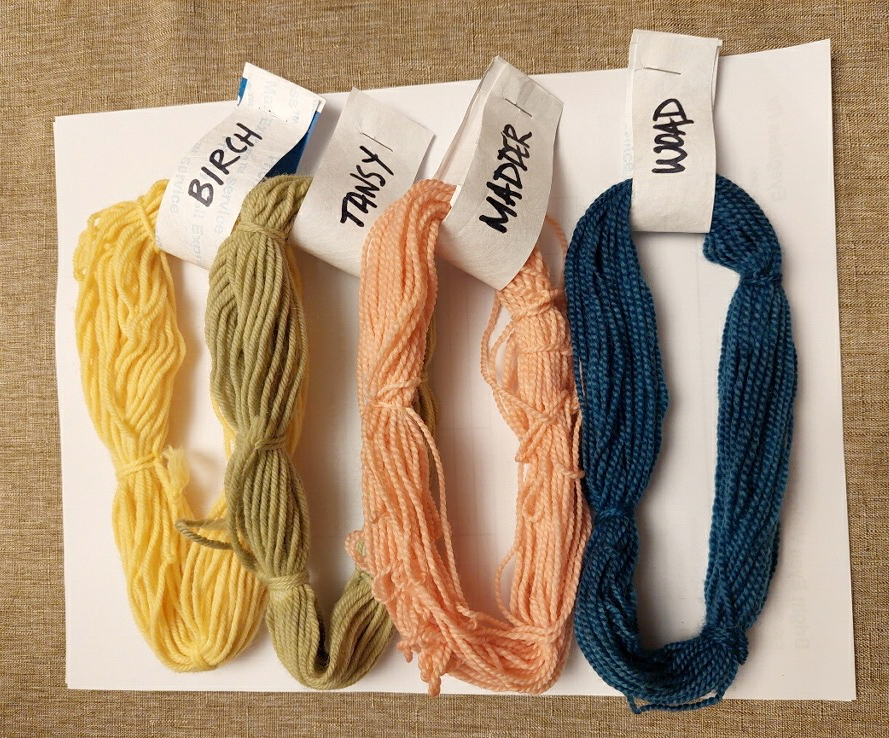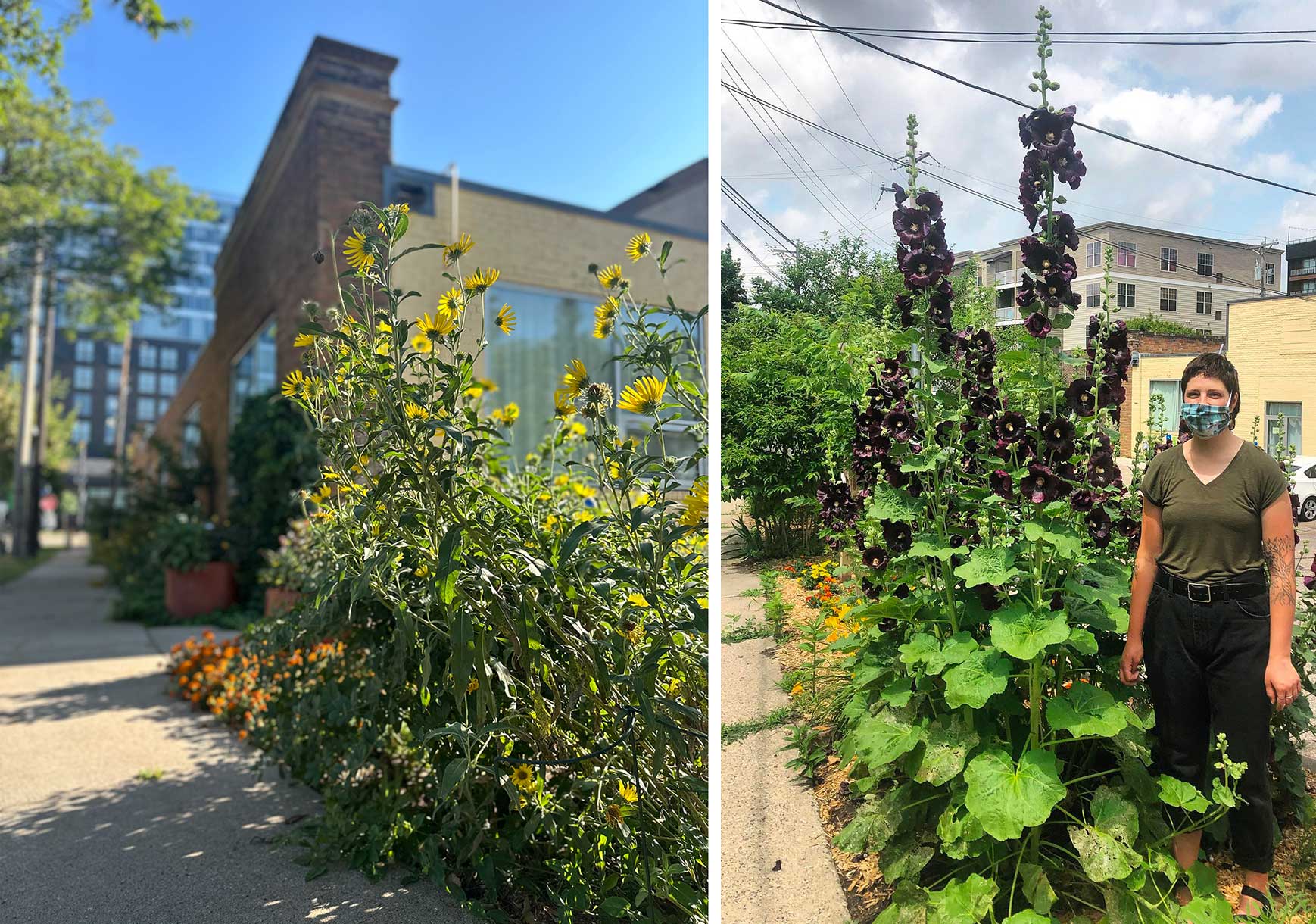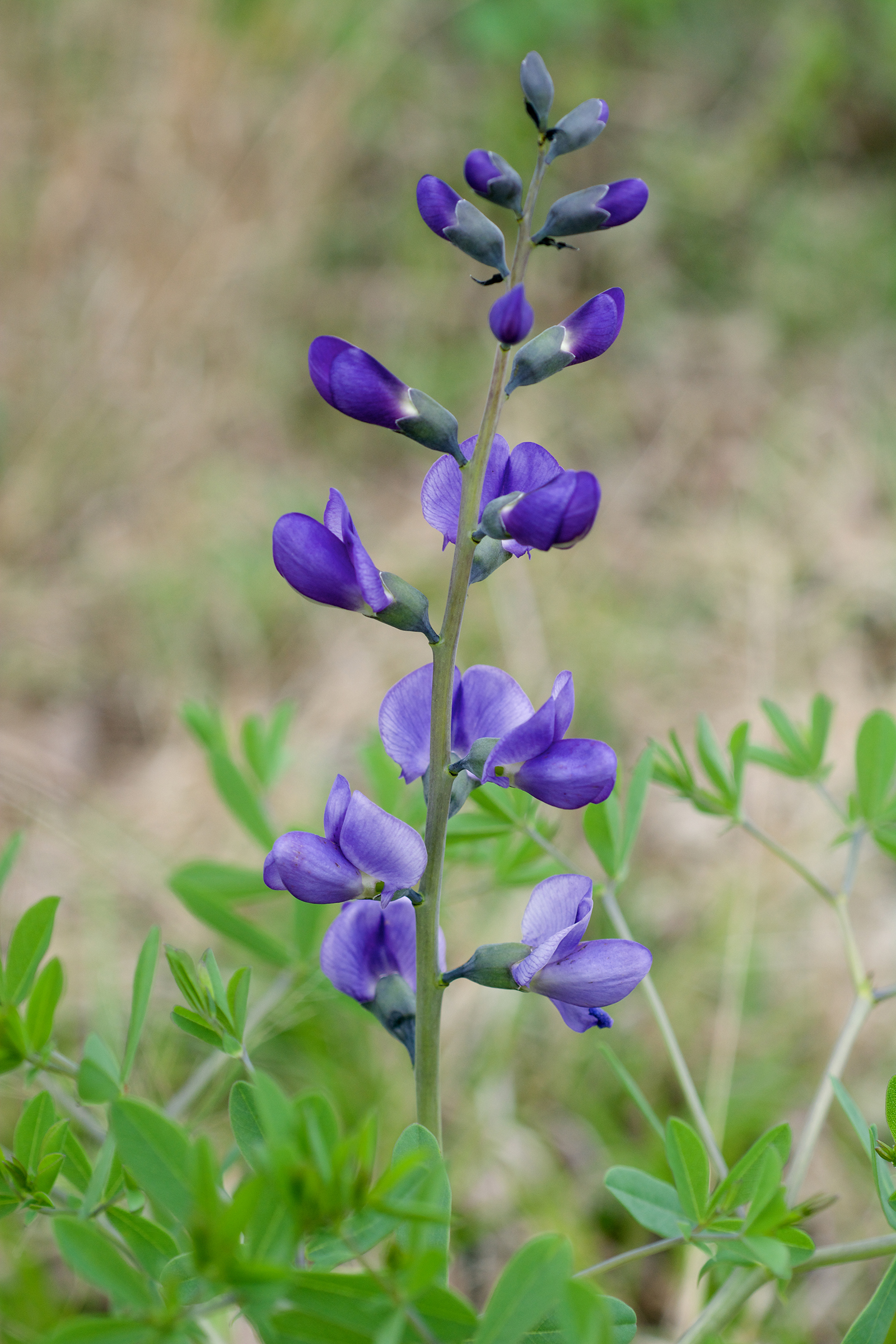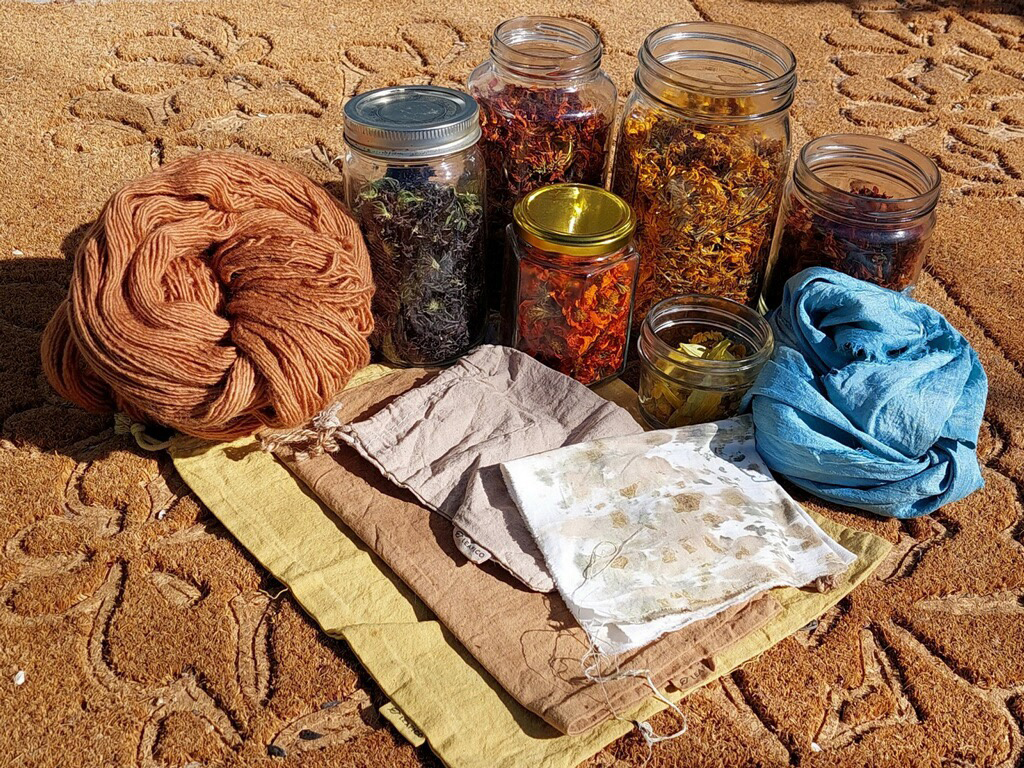During the early days of the pandemic lockdown, I was yearning for a new crafty endeavor that would also connect me in real-time with other like-minded souls. While perusing the Minneapolis Community Education bulletin, I happened upon a remote Bundle Dyeing class.
Wow, who knew that there was a craft that combined my love of gardening with my passion for textiles? This sparked my love affair for eco-dyeing, while being able to convince my spouse that I was not about to heavily invest in “yet another craft”!
 Eco-dyeing uses plant materials to create natural dyes for wool, silk, and cotton fabrics and yarns. It was the main method to color fabrics for centuries, until 1856 when synthetic dye was discovered.
Eco-dyeing uses plant materials to create natural dyes for wool, silk, and cotton fabrics and yarns. It was the main method to color fabrics for centuries, until 1856 when synthetic dye was discovered.
Synthetic dyeing requires vast amounts of water, and creates chemical waste often dumped into waterways. Eco-dyeing offers advantages of dyeing with minimal impact to the environment, as most dye materials are biodegradable, renewable, and compostable.
Several long-time favorite garden plants are dye plants. Marigold flowers, for instance, are an excellent choice for a first foray into eco-dyeing. You’ll find a number of new plants at the plant sale this year that are grown more specifically for dyeing.
To learn more about eco-dyeing, the Minnesota Textile Center in Minneapolis is a great resource. It features a dye garden and offers classes in eco-dyeing for all ages. Starting your own dye garden can be as simple as a potted plant or a few plants tucked into your vegetable garden, or as complicated as planning an entire dedicated garden space. —Meg E.
Basic tips
- To get started with eco-dyeing, read a good overview, take a class, or work alongside someone who can teach you.
- For the beginner, it’s easier to start with protein fibers (wool or silk) than cellulose (cotton, hemp, or linen). It’s also easier to start with yarn than with fabric.
- Bundle dyeing uses fresh or dried plant matter, such as flower petals, with steam to transfer color to fabric. It’s a great introductory eco-dyeing activity for all ages.
- Experimenting and keeping records of what you try is always worth it.
- There can be substances that require gloves and masks (see What’s a mordant?, p. 31). Your pots and kettles should be dedicated to dyeing; thrift shops and garage sales are a great resource. Take care!
Dye plants in the catalog
Herbs
• Bay laurel leaves • Henna*: in addition to its well-known use on skin and hair, henna creates greens and browns when dyeing fabrics, depending on the material • Madder*: the roots produce red and orange. Not harvestable for the first three years • Indigo, Japanese*: varying shades of blue. Green leaves create a beautiful robin’s egg color; fermented leaves result in classic indigo shades • Magenta plant: flavorless color is extracted from the leaves by boiling and used to color cakes and rice desserts • Turmeric root • Weld*: produces a great yellow for inks or dye. Can be invasive if allowed to reseed • Woad*: the first blue available in Europe. Can be invasive if allowed to reseed
Annuals
• Bachelor’s buttons (Centaurea) • Black-eyed Susan (Rudbeckia) • Cosmos: Diablo gives a tangerine dye. • Dyer’s coreopsis • Larkspur • Marigolds • Pincushion flower (Scabiosa): Black Knight • Dahlias • Sunflowers: flowers for yellow, and Hopi Black Dye seeds are particularly good for gray
Perennials
• Foxglove (also in Unusual) • Golden Marguerite* • Hibiscus: darker flowers produce more color • Hollyhocks: the darker reds like Spotlight Blacknight produce the best color • Russian sage • Wild indigo (Baptisia)
Climbers
• Hops: all parts of the plant will produce a beige color
Miniatures
• Lavender cotton (Santolina)
Vegetables
• Beets • Malabar spinach “berries” • Onion skins • Spinach (Spinacia)
Native Perennials and Shrubs/Trees
• Black-eyed Susan (Rudbeckia): yellows • Bloodroot: red from the roots (also in Unusual & Rare) • Red elderberries*: berries • Goldenrod: flowers produce yellows • Joe Pye weed: flowers produce pinks • Early sunflower (Heliopsis): yellows • Yarrow, white (Achillea): flowers produce beige to yellows
Fruit
• Blackberries: the berries create a bluish hue, the leaves a yellow to brown • Blueberries • Cherries • Black elderberries: pink • Mulberries • Rhubarb: the roots produce yellow to tangerine to green, depending on mordant Leaves used as a mordant.
* New plant for 2024
Thanks to Hennepin County Master Gardener Deb Reierson for many of the plant ideas and uses shared.
Learn more
Websites
- All Natural Dyeing
- The Learn section of Botanical Colors
- The Maiwa Guide to Natural Dyes
- “A brief history of colour, the environmental impact of synthetic dyes, and removal by using laccases.” Ardila-Leal LD, et al. In Molecules. 2021;26(13):3813.
- 7 Things You Should Know About Japanese Indigo Dye. On JapanObjects.com.
- Bloom & Dye: How to bundle-dye
Books
- Flint, India. Eco Colour: Botanical Dyes for Beautiful Textiles. Krause Craft, Iola WI, 2010.
- Pate, Maggie. The Natural Colors Cookbook. Page Street Publishing Co, Salem MA, 2018.
- Vejar, Kristine. The Modern Natural Dyer. Abrams, New York NY, 2015.
Local classes
- Minnesota Textile Center: For adults or for youth and families.
- American Swedish Institute
- Marine Mills Folk School: Occasional classes on dyeing

The Minnesota Textile Center, located at 3000 University Avenue SE in Minneapolis, has a dye garden as part of its education program. Run with support from volunteers from late May until mid-September, there are opportunities for group-gardening and independent drop-in volunteer upkeep. (Native sunflowers, left, and hollyhocks, right.)
Some questions
How do you get blue?
 In Europe, woad (Isatis tinctoria) was the only choice for blue before trade routes connected East and West, and true indigo (Indigofera tinctoria) became available from India. In Japan, a different plant that gives a blue dye also came to be called Japanese indigo in English (Polygonum tinctorium). A number of other flowers result in less intense blues: wild indigo, larkspurs and delphiniums, and bachelor’s buttons, plus blue- and blackberries. (When using the flowers of wild indigo, use only the species plant, not the cultivars. The seeds produce a nice gray.)
In Europe, woad (Isatis tinctoria) was the only choice for blue before trade routes connected East and West, and true indigo (Indigofera tinctoria) became available from India. In Japan, a different plant that gives a blue dye also came to be called Japanese indigo in English (Polygonum tinctorium). A number of other flowers result in less intense blues: wild indigo, larkspurs and delphiniums, and bachelor’s buttons, plus blue- and blackberries. (When using the flowers of wild indigo, use only the species plant, not the cultivars. The seeds produce a nice gray.)
What's a mordant?
A mineral salt that fixes with the fiber and allows natural dyes to bond to it. Mordants improve light- and wash-fastness, which makes for durable and long-lasting colors. Plant fibers require more mordant use than animal fibers. The name comes from the Latin word mordere, “to bite.” Tannic acid—naturally found in plant materials like onion and avocado skins, or black walnut and acorn husks—is a mordant. So is the iron in rusty nails.
How do you get yellow?
 Yellows can be achieved from a number of plants. Any varieties of marigolds can be mixed together for yellow dye. Some of the other plants that produce yellow dye: golden Marguerite, black-eyed Susans, dahlias — no matter what color the flower is, sunflowers and early sunflowers, and goldenrod.
Yellows can be achieved from a number of plants. Any varieties of marigolds can be mixed together for yellow dye. Some of the other plants that produce yellow dye: golden Marguerite, black-eyed Susans, dahlias — no matter what color the flower is, sunflowers and early sunflowers, and goldenrod.
What's this about colorfast?
An important term in dyeing, colorfast means having color that does not fade or run with washing. It is directly proportional to the binding force between the dye and the fiber. Lightfastness, wash-fastness, and rub-fastness are the main forms of color-fastness. Each one is standardized. Mordants affect the color-fastness of many eco-dyes.
How do you get red?
 Bloodroot is one of the plants that can create a red dye. The roots are harvested in fall to dry and powder, resulting in the intense red. Other reds come from darker hollyhock flowers and madder roots. Oranges and pinks come from flowers with similar petal colors.
Bloodroot is one of the plants that can create a red dye. The roots are harvested in fall to dry and powder, resulting in the intense red. Other reds come from darker hollyhock flowers and madder roots. Oranges and pinks come from flowers with similar petal colors.
Why are these the species names of dye plants?
tinctoria, tinctorium: The Latin word tinctura means the act of dyeing or tingeing, from tinctus “dye,” the past participle of tingere “to tinge, dye, soak in color.” Originally it was only “to moisten, wet, soak,” from the Proto-Indo-European root *teng- “to soak.”

From left to right: Black walnut dye on merino wool yarn. Reusable produce bags dyed with goldenrod, acorns, and red cabbage, below fabric bundle-dyed with Scabiosa Black Knight and rose petals. Jars filled with dried marigolds and Scabiosa blooms for future use. Silk dyed with fresh Japanese indigo.
_________
Photo credits: Four yarns by Meg E. Dye garden images courtesy of the Minnesota Textile Center. Blue wild indigo by Eric Hunt CC BY-SA 4.0. Marigolds by KOR!AN CC BY-SA 3.0. Bloodroot from the University of St. Thomas Medicinal Garden. Dried flowers and dyed materials by Meg E.